Xingyi Yang
C4D: 4D Made from 3D through Dual Correspondences
Oct 16, 2025Abstract:Recovering 4D from monocular video, which jointly estimates dynamic geometry and camera poses, is an inevitably challenging problem. While recent pointmap-based 3D reconstruction methods (e.g., DUSt3R) have made great progress in reconstructing static scenes, directly applying them to dynamic scenes leads to inaccurate results. This discrepancy arises because moving objects violate multi-view geometric constraints, disrupting the reconstruction. To address this, we introduce C4D, a framework that leverages temporal Correspondences to extend existing 3D reconstruction formulation to 4D. Specifically, apart from predicting pointmaps, C4D captures two types of correspondences: short-term optical flow and long-term point tracking. We train a dynamic-aware point tracker that provides additional mobility information, facilitating the estimation of motion masks to separate moving elements from the static background, thus offering more reliable guidance for dynamic scenes. Furthermore, we introduce a set of dynamic scene optimization objectives to recover per-frame 3D geometry and camera parameters. Simultaneously, the correspondences lift 2D trajectories into smooth 3D trajectories, enabling fully integrated 4D reconstruction. Experiments show that our framework achieves complete 4D recovery and demonstrates strong performance across multiple downstream tasks, including depth estimation, camera pose estimation, and point tracking. Project Page: https://littlepure2333.github.io/C4D
Don't Forget the Nonlinearity: Unlocking Activation Functions in Efficient Fine-Tuning
Sep 16, 2025Abstract:Existing parameter-efficient fine-tuning (PEFT) methods primarily adapt weight matrices while keeping activation functions fixed. We introduce \textbf{NoRA}, the first PEFT framework that directly adapts nonlinear activation functions in pretrained transformer-based models. NoRA replaces fixed activations with learnable rational functions and applies structured low-rank updates to numerator and denominator coefficients, with a group-wise design that localizes adaptation and improves stability at minimal cost. On vision transformers trained on CIFAR-10 and CIFAR-100, NoRA matches or exceeds full fine-tuning while updating only 0.4\% of parameters (0.02M), achieving accuracy gains of +0.17\% and +0.27\%. When combined with LoRA (\textbf{NoRA++}), it outperforms LoRA and DoRA under matched training budgets by adding fewer trainable parameters. On LLaMA3-8B instruction tuning, NoRA++ consistently improves generation quality, yielding average MMLU gains of +0.3\%--0.8\%, including +1.6\% on STEM (Alpaca) and +1.3\% on OpenOrca. We further show that NoRA constrains adaptation to a low-dimensional functional subspace, implicitly regularizing update magnitude and direction. These results establish activation-space tuning as a complementary and highly parameter-efficient alternative to weight-based PEFT, positioning activation functions as first-class objects for model adaptation.
Test3R: Learning to Reconstruct 3D at Test Time
Jun 16, 2025Abstract:Dense matching methods like DUSt3R regress pairwise pointmaps for 3D reconstruction. However, the reliance on pairwise prediction and the limited generalization capability inherently restrict the global geometric consistency. In this work, we introduce Test3R, a surprisingly simple test-time learning technique that significantly boosts geometric accuracy. Using image triplets ($I_1,I_2,I_3$), Test3R generates reconstructions from pairs ($I_1,I_2$) and ($I_1,I_3$). The core idea is to optimize the network at test time via a self-supervised objective: maximizing the geometric consistency between these two reconstructions relative to the common image $I_1$. This ensures the model produces cross-pair consistent outputs, regardless of the inputs. Extensive experiments demonstrate that our technique significantly outperforms previous state-of-the-art methods on the 3D reconstruction and multi-view depth estimation tasks. Moreover, it is universally applicable and nearly cost-free, making it easily applied to other models and implemented with minimal test-time training overhead and parameter footprint. Code is available at https://github.com/nopQAQ/Test3R.
Image Editing As Programs with Diffusion Models
Jun 04, 2025Abstract:While diffusion models have achieved remarkable success in text-to-image generation, they encounter significant challenges with instruction-driven image editing. Our research highlights a key challenge: these models particularly struggle with structurally inconsistent edits that involve substantial layout changes. To mitigate this gap, we introduce Image Editing As Programs (IEAP), a unified image editing framework built upon the Diffusion Transformer (DiT) architecture. At its core, IEAP approaches instructional editing through a reductionist lens, decomposing complex editing instructions into sequences of atomic operations. Each operation is implemented via a lightweight adapter sharing the same DiT backbone and is specialized for a specific type of edit. Programmed by a vision-language model (VLM)-based agent, these operations collaboratively support arbitrary and structurally inconsistent transformations. By modularizing and sequencing edits in this way, IEAP generalizes robustly across a wide range of editing tasks, from simple adjustments to substantial structural changes. Extensive experiments demonstrate that IEAP significantly outperforms state-of-the-art methods on standard benchmarks across various editing scenarios. In these evaluations, our framework delivers superior accuracy and semantic fidelity, particularly for complex, multi-step instructions. Codes are available at https://github.com/YujiaHu1109/IEAP.
Minute-Long Videos with Dual Parallelisms
May 29, 2025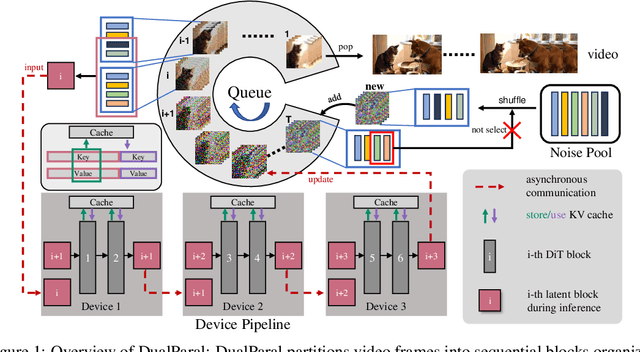


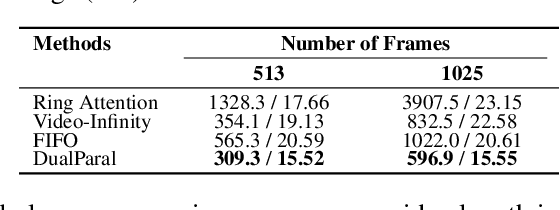
Abstract:Diffusion Transformer (DiT)-based video diffusion models generate high-quality videos at scale but incur prohibitive processing latency and memory costs for long videos. To address this, we propose a novel distributed inference strategy, termed DualParal. The core idea is that, instead of generating an entire video on a single GPU, we parallelize both temporal frames and model layers across GPUs. However, a naive implementation of this division faces a key limitation: since diffusion models require synchronized noise levels across frames, this implementation leads to the serialization of original parallelisms. We leverage a block-wise denoising scheme to handle this. Namely, we process a sequence of frame blocks through the pipeline with progressively decreasing noise levels. Each GPU handles a specific block and layer subset while passing previous results to the next GPU, enabling asynchronous computation and communication. To further optimize performance, we incorporate two key enhancements. Firstly, a feature cache is implemented on each GPU to store and reuse features from the prior block as context, minimizing inter-GPU communication and redundant computation. Secondly, we employ a coordinated noise initialization strategy, ensuring globally consistent temporal dynamics by sharing initial noise patterns across GPUs without extra resource costs. Together, these enable fast, artifact-free, and infinitely long video generation. Applied to the latest diffusion transformer video generator, our method efficiently produces 1,025-frame videos with up to 6.54$\times$ lower latency and 1.48$\times$ lower memory cost on 8$\times$RTX 4090 GPUs.
Flash Sculptor: Modular 3D Worlds from Objects
Apr 08, 2025Abstract:Existing text-to-3D and image-to-3D models often struggle with complex scenes involving multiple objects and intricate interactions. Although some recent attempts have explored such compositional scenarios, they still require an extensive process of optimizing the entire layout, which is highly cumbersome if not infeasible at all. To overcome these challenges, we propose Flash Sculptor in this paper, a simple yet effective framework for compositional 3D scene/object reconstruction from a single image. At the heart of Flash Sculptor lies a divide-and-conquer strategy, which decouples compositional scene reconstruction into a sequence of sub-tasks, including handling the appearance, rotation, scale, and translation of each individual instance. Specifically, for rotation, we introduce a coarse-to-fine scheme that brings the best of both worlds--efficiency and accuracy--while for translation, we develop an outlier-removal-based algorithm that ensures robust and precise parameters in a single step, without any iterative optimization. Extensive experiments demonstrate that Flash Sculptor achieves at least a 3 times speedup over existing compositional 3D methods, while setting new benchmarks in compositional 3D reconstruction performance. Codes are available at https://github.com/YujiaHu1109/Flash-Sculptor.
1000+ FPS 4D Gaussian Splatting for Dynamic Scene Rendering
Mar 20, 2025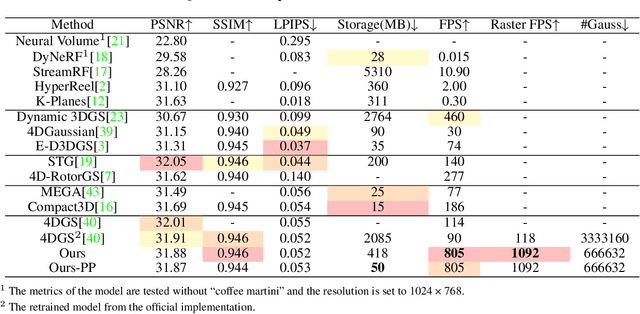


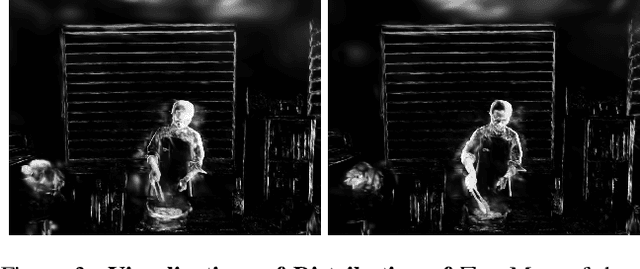
Abstract:4D Gaussian Splatting (4DGS) has recently gained considerable attention as a method for reconstructing dynamic scenes. Despite achieving superior quality, 4DGS typically requires substantial storage and suffers from slow rendering speed. In this work, we delve into these issues and identify two key sources of temporal redundancy. (Q1) \textbf{Short-Lifespan Gaussians}: 4DGS uses a large portion of Gaussians with short temporal span to represent scene dynamics, leading to an excessive number of Gaussians. (Q2) \textbf{Inactive Gaussians}: When rendering, only a small subset of Gaussians contributes to each frame. Despite this, all Gaussians are processed during rasterization, resulting in redundant computation overhead. To address these redundancies, we present \textbf{4DGS-1K}, which runs at over 1000 FPS on modern GPUs. For Q1, we introduce the Spatial-Temporal Variation Score, a new pruning criterion that effectively removes short-lifespan Gaussians while encouraging 4DGS to capture scene dynamics using Gaussians with longer temporal spans. For Q2, we store a mask for active Gaussians across consecutive frames, significantly reducing redundant computations in rendering. Compared to vanilla 4DGS, our method achieves a $41\times$ reduction in storage and $9\times$ faster rasterization speed on complex dynamic scenes, while maintaining comparable visual quality. Please see our project page at https://4DGS-1K.github.io.
OminiControl2: Efficient Conditioning for Diffusion Transformers
Mar 11, 2025Abstract:Fine-grained control of text-to-image diffusion transformer models (DiT) remains a critical challenge for practical deployment. While recent advances such as OminiControl and others have enabled a controllable generation of diverse control signals, these methods face significant computational inefficiency when handling long conditional inputs. We present OminiControl2, an efficient framework that achieves efficient image-conditional image generation. OminiControl2 introduces two key innovations: (1) a dynamic compression strategy that streamlines conditional inputs by preserving only the most semantically relevant tokens during generation, and (2) a conditional feature reuse mechanism that computes condition token features only once and reuses them across denoising steps. These architectural improvements preserve the original framework's parameter efficiency and multi-modal versatility while dramatically reducing computational costs. Our experiments demonstrate that OminiControl2 reduces conditional processing overhead by over 90% compared to its predecessor, achieving an overall 5.9$\times$ speedup in multi-conditional generation scenarios. This efficiency enables the practical implementation of complex, multi-modal control for high-quality image synthesis with DiT models.
Efficient Gaussian Splatting for Monocular Dynamic Scene Rendering via Sparse Time-Variant Attribute Modeling
Feb 27, 2025Abstract:Rendering dynamic scenes from monocular videos is a crucial yet challenging task. The recent deformable Gaussian Splatting has emerged as a robust solution to represent real-world dynamic scenes. However, it often leads to heavily redundant Gaussians, attempting to fit every training view at various time steps, leading to slower rendering speeds. Additionally, the attributes of Gaussians in static areas are time-invariant, making it unnecessary to model every Gaussian, which can cause jittering in static regions. In practice, the primary bottleneck in rendering speed for dynamic scenes is the number of Gaussians. In response, we introduce Efficient Dynamic Gaussian Splatting (EDGS), which represents dynamic scenes via sparse time-variant attribute modeling. Our approach formulates dynamic scenes using a sparse anchor-grid representation, with the motion flow of dense Gaussians calculated via a classical kernel representation. Furthermore, we propose an unsupervised strategy to efficiently filter out anchors corresponding to static areas. Only anchors associated with deformable objects are input into MLPs to query time-variant attributes. Experiments on two real-world datasets demonstrate that our EDGS significantly improves the rendering speed with superior rendering quality compared to previous state-of-the-art methods.
GraphBridge: Towards Arbitrary Transfer Learning in GNNs
Feb 26, 2025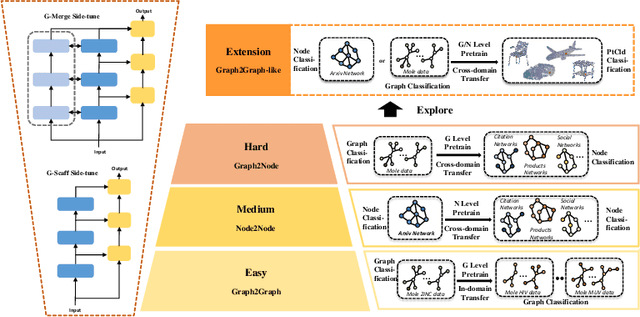
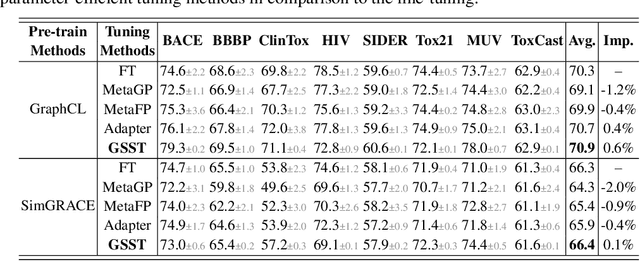
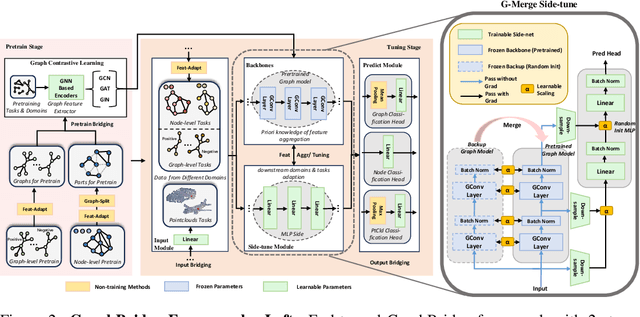
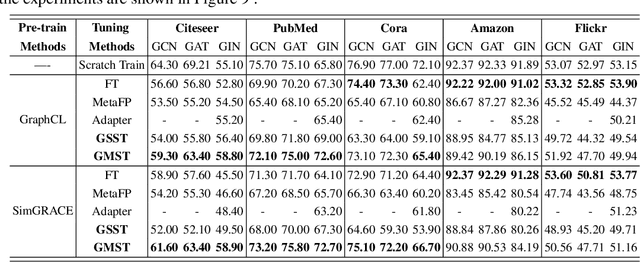
Abstract:Graph neural networks (GNNs) are conventionally trained on a per-domain, per-task basis. It creates a significant barrier in transferring the acquired knowledge to different, heterogeneous data setups. This paper introduces GraphBridge, a novel framework to enable knowledge transfer across disparate tasks and domains in GNNs, circumventing the need for modifications to task configurations or graph structures. Specifically, GraphBridge allows for the augmentation of any pre-trained GNN with prediction heads and a bridging network that connects the input to the output layer. This architecture not only preserves the intrinsic knowledge of the original model but also supports outputs of arbitrary dimensions. To mitigate the negative transfer problem, GraphBridg merges the source model with a concurrently trained model, thereby reducing the source bias when applied to the target domain. Our method is thoroughly evaluated across diverse transfer learning scenarios, including Graph2Graph, Node2Node, Graph2Node, and graph2point-cloud. Empirical validation, conducted over 16 datasets representative of these scenarios, confirms the framework's capacity for task- and domain-agnostic transfer learning within graph-like data, marking a significant advancement in the field of GNNs.
 Add to Chrome
Add to Chrome Add to Firefox
Add to Firefox Add to Edge
Add to Edge